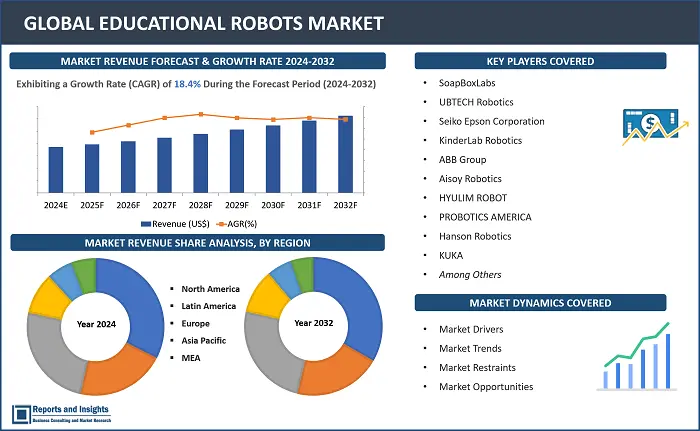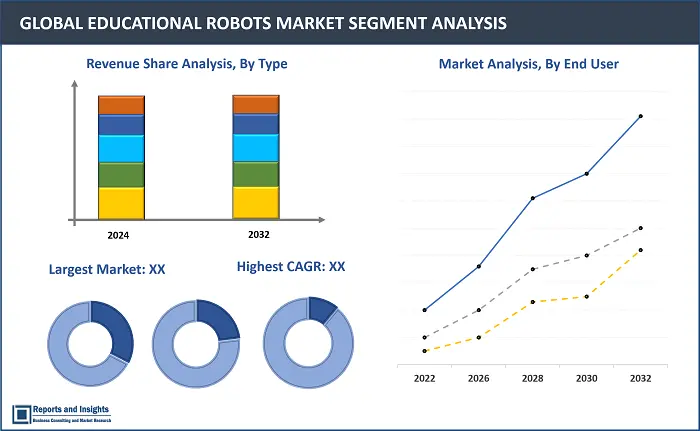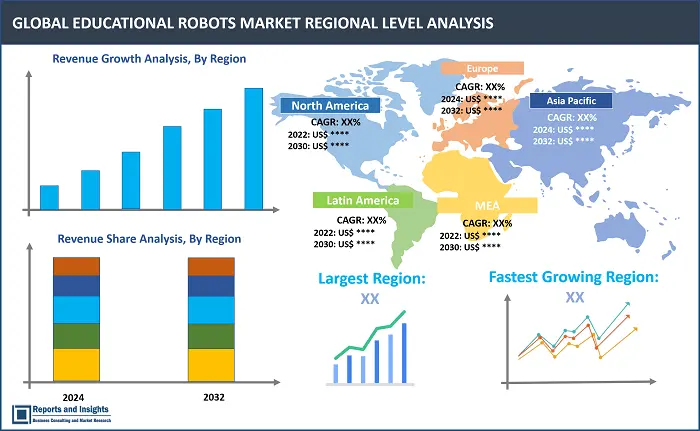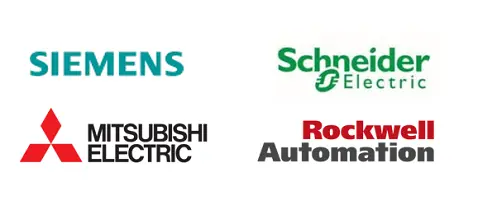Market Overview:
"The educational robots market size reached US$ 2.6 billion in 2023. Looking forward, Reports and Insights expects the market to reach US$ 23.18 by 2032, exhibiting a growth rate (CAGR) of 18.4% during 2024-2032."
|
Report Attributes |
Details |
|
Base Year |
2023 |
|
Forecast Years |
2024-2032 |
|
Historical Years |
2021-2023 |
|
Market Growth Rate (2024-2032) |
18.4% |
Educational robots refer to specialized robotic devices designed to enhance the learning experience in educational settings. These robots are equipped with interactive features, programming capabilities, and often incorporate elements of artificial intelligence to engage students across various subjects, particularly in science, technology, engineering, and mathematics. Serving as tools to promote hands-on learning, problem-solving, and creativity, educational robots enable students to program and manipulate them to perform tasks. Ranging from simple programmable toys for early childhood education to more advanced platforms in higher education, these robots play a crucial role in creating dynamic and interactive learning environments. Their utilization encourages the development of critical skills necessary for addressing the technological challenges of the future.
The educational robots’ market is undergoing rapid expansion as technological innovations reshape the educational landscape. These specialized robotic devices are increasingly incorporated into educational programs, particularly in STEM fields, to enrich learning experiences. Fueled by advancements in artificial intelligence and programming capabilities, these robots actively engage students in hands-on activities, fostering critical thinking, problem-solving, and coding skills. From programmable toys catering to early education to sophisticated platforms designed for higher learning, the market offers a diverse array of products. With a focus on creating interactive and dynamic learning environments, the educational robots’ market is poised for growth, driven by the increasing demand for technology-integrated education and the acknowledgment of robotics as a valuable tool for nurturing essential skills in students.

Educational Robot Market Trends and Drivers
The educational robot market is experiencing dynamic growth driven by prominent trends and key drivers. The global emphasis on STEM education has significantly boosted the adoption of educational robots, recognizing their pivotal role in fostering skills in science, technology, engineering, and mathematics. Advances in artificial intelligence and robotics technologies are facilitating the creation of more sophisticated and interactive educational robots, offering students hands-on learning experiences. Furthermore, the increasing awareness of the significance of coding and programming skills in the digital era is spurring the integration of educational robots into curricula to impart these essential competencies. These prevailing trends collectively contribute to a dynamic landscape for the educational robot market, highlighting its crucial role in shaping contemporary education approaches.
Educational robots market growth is influenced by several factors which include the widespread adoption of educational robots to enhance learning in science, technology, engineering, and mathematics. Continuous technological advancements, especially in artificial intelligence and robotics, contribute to the creation of more advanced and interactive educational robots, positioning them as essential tools for hands-on learning experiences. Furthermore, the growing acknowledgment of coding and programming skills as crucial competencies in the digital era has stimulated the integration of educational robots into educational curricula, collectively fostering a conducive environment for the market's robust growth.
Educational Robot Market Restraining Factors
Several factors act as constraints on the growth of the educational robot market. Affordability stands out as a significant challenge, with the high costs associated with advanced educational robots, featuring artificial intelligence and state-of-the-art technology, serving as a barrier for educational institutions with limited budgets. The integration of robots into existing curricula and educational systems poses challenges, necessitating substantial adjustments and teacher training. Concerns about data privacy and security in children's interactions with robots introduce regulatory and ethical considerations. The learning curve involved in integrating robotics into traditional teaching methods may generate resistance among educators. Additionally, the dynamic nature of technology and the rapid obsolescence of certain robot models may discourage long-term investments. Together, these factors contribute to obstacles that impede the seamless adoption and expansion of educational robots across various educational environments.
Educational Robot Market Opportunities
The educational robot market presents promising opportunities driven by various factors. The increasing global focus on technology-integrated learning methods, particularly in STEM education, positions educational robots as vital tools for enhancing students' critical thinking and problem-solving skills. The growing demand for coding and programming skills in the digital age enhances the market's prospects, as educational robots become instrumental in teaching these essential competencies. Furthermore, the potential for customization and innovation in educational robot offerings, catering to diverse educational levels and curricula, opens avenues for market expansion. As educational institutions seek interactive and engaging teaching tools, the opportunities for growth in the educational robot market are underscored by the evolving landscape of modern education and the continuous integration of technology into learning environments.
Educational Robot Market Segmentation

By Type
- Humanoid Robots
- Collaborative Industrial Robots
The segmentation "By Type" in the robotics sector categorizes robots into humanoid robots and collaborative industrial robots. Humanoid robots, designed to mimic human characteristics, find applications in education, healthcare, and customer service, providing interactive and empathetic interactions. In contrast, collaborative industrial robots are engineered for co-working with humans in manufacturing settings, enhancing efficiency and safety through human-robot collaboration. These robots employ advanced sensors and technologies to operate safely in shared workspaces, fostering a synergistic relationship between human workers and automation. This classification highlights the diverse applications and functionalities within robotics, addressing needs in both service-oriented and industrial environments.
By Component
- Sensors
- End-Effectors
- Actuators
- Controllers
The segmentation "By Component" classifies robotics based on four fundamental elements: sensors, end-effectors, actuators, and controllers. Sensors play a pivotal role in gathering data from the robot's environment, providing crucial information for decision-making and navigation. End-effectors encompass the tools or attachments at the robot's extremity, enabling effective interaction and manipulation of its surroundings. Actuators are responsible for converting electrical signals into mechanical movement, facilitating the execution of tasks by the robot. Controllers act as the central processing unit, coordinating communication and collaboration among sensors, actuators, and end-effectors. This categorization underscores the essential components that collectively contribute to the functionality, adaptability, and precision of robotic systems across various industries and applications.
By End-User
- Primary Education
- Secondary Education
- Higher Education
- Others
The segmentation "By End-User" categorizes the application of robotics in education across various levels. In primary education, robots are utilized to enrich interactive learning experiences, fostering engagement and introducing fundamental concepts in a playful manner. Secondary education sees robotics as a tool for more advanced learning, integrating hands-on applications to teach complex subjects like programming and engineering. In higher education, robotics assumes a research-oriented role, with applications in fields such as artificial intelligence and robotics engineering. The "Others" category encompasses vocational training institutions and specialized educational programs utilizing robotics for skill development. This categorization underscores the adaptability of robotics in addressing a spectrum of educational levels, from foundational learning to advanced research and specialized training.
By Region

North America
- United States
- Canada
Europe
- Germany
- United Kingdom
- France
- Italy
- Spain
- Russia
- Poland
- Benelux
- Nordic
- Rest of Europe
Asia Pacific
- China
- Japan
- India
- South Korea
- ASEAN
- Australia & New Zealand
- Rest of Asia Pacific
Latin America
- Brazil
- Mexico
- Argentina
Middle East & Africa
- Saudi Arabia
- South Africa
- United Arab Emirates
- Israel
- Rest of MEA
North America serves as a pivotal region for the deployment of educational robots, particularly in the United States and Canada. The educational landscape in this region showcases a widespread embrace of robotic technology across different academic levels, emphasizing a commitment to enhancing STEM education. Educational robots play a vital role in promoting interactive and hands-on learning experiences, fostering skill development in areas like programming and engineering. The region's leadership in the field is reinforced by its advanced technological infrastructure, a culture of educational innovation, and a proactive approach to integrating robotics into educational curricula. With the presence of influential stakeholders, educational institutions, and initiatives dedicated to advancing technological literacy, North America remains at the forefront of shaping the future of education through the integration of robotics.
Leading Educational Robot Manufacturers & Competitive Landscape:
The educational robot market is highly competitive, with several key players vying for market share and actively engaging in strategic initiatives. These companies focus on product innovation, technological advancements, and expanding their product portfolios to gain a competitive edge. These companies are continuously investing in research and development activities to enhance their product offerings and cater to the evolving needs of customers in terms of efficiency, performance, and sustainability.
These companies include:
- SoapBoxLabs
- UBTECH Robotics
- Seiko Epson Corporation
- KinderLab Robotics
- ABB Group
- Aisoy Robotics
- HYULIM ROBOT
- PROBOTICS AMERICA
- Hanson Robotics
- KUKA
- SoftBank Robotics Group
- Robolink
- FANUC CORPORATION
- YASKAWA ELECTRIC CORPORATION
- Robotis
- Universal Robots
- Sanbot Innovation Technology.
Recent Development:
- August 2022: Google is directing its efforts towards addressing the market demand for humanoid robots. Researchers at Google's lab have successfully developed AI software integrating large language models, aiming to assist humans in accomplishing daily tasks. This research is anticipated to bring about significant transformations in the landscape of home-schooling in the foreseeable future.
- March 2022: Intuition Robotics officially launched ElliQ, a digital care companion, and it is now available for purchase at elliq.com.
Educational Robot Research Scope
|
Report Metric |
Report Details |
|
Market size available for the years |
2021-2023 |
|
Base Year |
2023 |
|
Forecast Period |
2024-2032 |
|
Compound Annual Growth Rate (CAGR) |
18.4% |
|
Segment covered |
Type, component, end-user and regions. |
|
Regions Covered |
North America: The U.S. & Canada Latin America: Brazil, Mexico, Argentina, & Rest of Latin America Asia Pacific: China, India, Japan, Australia & New Zealand, ASEAN, & Rest of Asia Pacific Europe: Germany, The U.K., France, Spain, Italy, Russia, Poland, BENELUX, NORDIC, & Rest of Europe The Middle East & Africa: Saudi Arabia, United Arab Emirates, South Africa, Egypt, Israel, and Rest of MEA |
|
Fastest Growing Country in Europe |
Germany |
|
Largest Market |
North America |
|
Key Players |
SoapBoxLabs, UBTECH Robotics, Seiko Epson Corporation, KinderLab Robotics, ABB Group, Aisoy Robotics, HYULIM ROBOT, PROBOTICS AMERICA, Hanson Robotics, KUKA, SoftBank Robotics Group, Robolink, FANUC CORPORATION, YASKAWA ELECTRIC CORPORATION, Robotis, Universal Robots, Sanbot Innovation Technology. |
Frequently Asked Question
What is the market size of educational robot market in the year 2023?
The educational robot market size reached USD 2.6 billion in 2023.
At what CAGR will the educational robot market expand?
The market is anticipated to rise at 18.4% CAGR through 2032.
What are some key factors driving revenue growth of the educational robot market?
Some key factors driving educational robot market revenue growth include emphasis on stem education, teacher training programs, development of advanced robotics, and investment in EdTech.
What are some major challenges faced by companies in the educational robot market?
Companies face challenges such as cost constraints, regulatory compliance, and global disparities in Education.
How is the competitive landscape in the educational robot market?
The market is competitive, with key players focusing on technological advancements, product innovation, and strategic partnerships. Factors such as product quality, reliability, after-sales services, and customization capabilities play a significant role in determining competitiveness.
How is the educational robot market segmented?
The market is segmented based on type, component, end-user and regions.
Who are the key players in educational robot market?
The key players in the educational robot market are SoapBoxLabs, UBTECH Robotics, Seiko Epson Corporation, KinderLab Robotics, ABB Group, Aisoy Robotics, HYULIM ROBOT, PROBOTICS AMERICA, Hanson Robotics, KUKA, SoftBank Robotics Group, Robolink, FANUC CORPORATION, YASKAWA ELECTRIC CORPORATION, Robotis, Universal Robots, Sanbot Innovation Technology.
What hardware component are included in educational robot market?
The hardware of educational robots includes sensors, end-effectors, actuators, and controllers.

